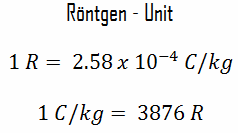Radiation exposure is a measure of the ionization of air due to ionizing radiation from high-energy photons (i.e., X-rays and gamma rays). Radiation exposure is defined as the sum of electrical charges (∆q) on all the ions of one sign produced in the air when all the electrons, liberated by photons in a volume of air whose mass is ∆m, are completely stopped in the air.
Radiation exposure is given the symbol X. The SI unit of radiation exposure is the coulomb per kilogram (C/kg), but in practice, the roentgen is used.
Roentgen – Unit of Radiation Exposure
The roentgen, abbreviated R, is the unit of radiation exposure. In the original definition, 1 R means the amount of X-rays or γ-radiation required to liberate positive and negative charges of one electrostatic unit of charge (esu) in 1 cm³ of dry air at standard temperature and pressure (STP). Note that 1 esu ≈ 3.33564×10−10 C. As a result, one roentgen corresponds to 2.58 x 10-4 coulomb per kg of ions generated in air, and an exposure of one coulomb per kilogram is equivalent to 3876 roentgens.
Radiation exposures measured in the industry (except nuclear medicine) often have comparable doses to one roentgen, and the following multiples are often used:
1 mR (milli roentgen) = 1E-3 R
1 kR (kilo roentgen) = 1E3 R
Calculating the radiation dose (in Gy) from radiation exposure of 1 R depends on the energy of the X-rays or γ-rays and the composition of the irradiated material. For example, if soft tissue is exposed to γ-rays of 1 R, the radiation dose will be approximately 9.3 milligrays (mGy).
Conversion: Exposure to Absorbed Dose
The dose is defined as the amount of energy deposited by ionizing radiation in a substance. For a given radiation field, the absorbed dose will depend on the type of matter which absorbs the radiation. Although many possible interactions are known, there are three key interaction mechanisms of gamma rays with matter.
For instance, for an exposure of 1 roentgen by gamma rays with an energy of 1 MeV, the dose in the air will be 0.876 rad. This can be determined using the ionization energy of dry air at 20 °C and 101.325 kPa of pressure, which is 33.97 J/C. Therefore, an exposure of 2.58×10−4 C/kg (1 roentgen) would deposit an absorbed dose of 8.76×10−3 J/kg (0.876 rad) in dry air under those conditions. A table giving the exposure to dose conversion for various materials for various gamma-ray energies can be found in the literature.

